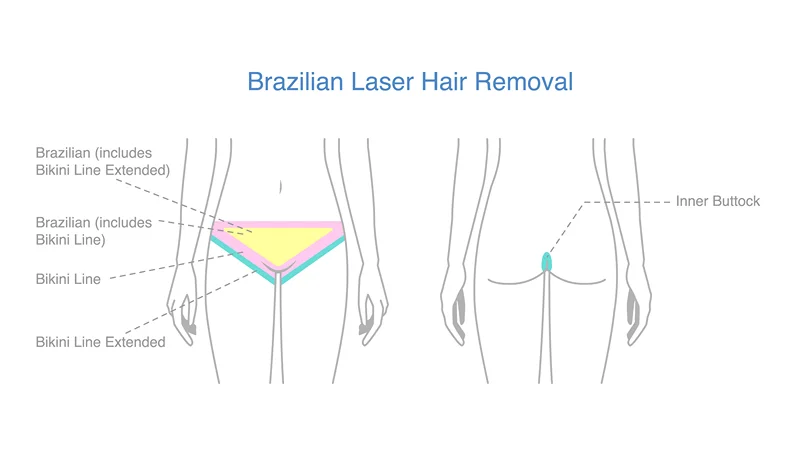Hair removal can be done manually or with the help of a specialist. Thanks to new technologies, more hair removal methods have become convenient and accessible. Treatments like Brazilian laser hair removal can even help people remove their unwanted pubic hair. These treatments are generally safe and hassle-free.
So can Brazilian laser hair removal get rid of unwanted hair permanently? This procedure removes unwanted body hair for a long time. It’s one of the longest-lasting hair removal solutions—you don’t have to undergo another treatment cycle for years.
Brazilian Laser Hair Removal as a Long-Term Solution to Unwanted Hair
Brazilian laser hair removal uses heat to damage the hair follicles in the pubic area. The lasers destroy the follicles and effectively block new hair growth for years. It’s a much more sustainable alternative to tweezing and shaving. Hair grows back in fewer amounts, and it’s easy to get follow-up treatment cycles from your preferred provider.
While laser hair removal effects last for a long time, it’s not a permanent solution. The procedure works best for people with lighter skin tones and darker hair. If you choose to undergo Brazilian laser hair removal, make sure to check if your specialist is board-certified and licensed in your state.
How the Procedure Works
Before beginning the procedure, your specialist will apply a topical numbing cream to the target area. The cream will help minimize any pain and discomfort during the procedure. The actual treatment begins when the laser beams release heat to the target areas below the skin. The targeted hair follicles will eventually cease to produce new hair strands.
Laser hair removal is best suited for people with light skin tones and dark hair colors. The lasers target the melanin content in the hair. Since blonde or red hair has less melanin content, the procedure may not be as effective.
Hair shedding can start a few days after undergoing the first laser treatment session. The procedure is generally quick, with most treatments lasting less than an hour. For instance, laser hair removal for the upper lip can take just 5 minutes. The pubic area may take about 20 minutes.
After your session, your doctor may ask you to wait for an hour before leaving. The waiting time allows your body to recover after the topical anesthetic’s effects wear off. The effects of a full treatment cycle can last anywhere from 2 to 6 years.
Frequency of Sessions
Follow-up laser sessions are required to maintain hair removal. Most patients will need more than a single session. The usual amount of treatments is 4 to 6 sessions per cycle. The usual interval between sessions is 4 to 6 weeks. A full treatment cycle may last for 7 to 9 months.
You’ll notice hair growth lessening after each session. Hair texture and color may also become lighter after a few weeks. Most people will experience a 10% to 25% decrease in hair growth after their first laser treatment.
After you finish your treatment cycle, you may need maintenance sessions. Depending on your individual treatment plan, these can occur once or twice a year after a treatment cycle. Effects will take 2 to 6 years to fully disappear without maintenance.
Possible Contraindications and Side Effects
People who have keloid scars, vitiligo, and urticaria may be asked to pursue alternative hair removal procedures instead. Other medical conditions that could make you incompatible with the procedure include:
- Herpes simplex
- Hives
- Hypertrophic scars
- Lupus
- Melanoma
- Scleroderma
Each patient will have an individual treatment plan that caters to their skin type. You will be carefully screened to prevent any adverse reactions. Make sure to disclose any medications you’re currently taking, as these can interfere with your laser treatment.
Side effects are minimal and typically resolve on their own. These are usually localized around the treatment site. In very rare cases, some people may develop scars, burns, or blisters around the operated area. Contact your doctor if you experience harsh skin irritation. To resolve these, you may be prescribed topical medication.
There’s a very small chance of infection after a Brazilian laser treatment. If you notice any of the following signs, contact your doctor right away:
- Fever
- Persistent pain and inflammation
- Pus leakage
- Large scarring
Duration of Effects Compared to Other Hair Removal Treatments

Brazilian laser hair removal is one of the longest-lasting procedures to remove pubic hair. Compared to other manual methods, laser hair removal is much more sustainable. The effects last for years, and maintenance sessions are quick and easy. It also stands out as a convenient and relatively painless option.
1) Shaving
Shaving is the most common hair removal method today. However, it’s notorious for causing nicks and cuts, especially if you use a faulty razor. Ingrown hairs are also a persistent problem in shaving. It also needs a lot of maintenance, as hair grows back at a fast rate.
2) Prescription Creams
There are prescription depilatory creams that destroy keratin in the hair. The creams dissolve the foundation of the hair, allowing it to break off after some time. These creams contain alkaline chemicals to break down the hair proteins. While you don’t have the risk of nicks and cuts, the effects don’t last long. Since the hair follicles aren’t destroyed, hair grows back after a few days.
3) Electrolysis
Brazilian laser therapy and electrolysis produce sustainable and long-term effects. Much like laser hair removal, electrolysis removes unwanted hair for years. There are also fewer side effects and follow-up treatments are scheduled according to your availability and medical history. However, electrolysis needs more sessions to fully remove unwanted body hair. Electrolysis also doesn’t work for large areas, making it less ideal for the pubic region.
Aftercare for Brazilian Laser Hair Removal
Much like other hair removal methods, Brazilian laser hair removal can lead to redness and skin irritation. These usually resolve on their own after a couple of days. There’s also very minimal downtime after a procedure, and you can return to work almost immediately.
Recovery Period
The recovery period after Brazilian laser hair removal is usually short. It takes a few days for the redness and irritation to subside after your first treatment. Your specialist will also prescribe a topical cream that can help minimize cosmetic side effects.
You may experience tiredness or slight fatigue after going home from the procedure. Make sure to drink enough water to help the body recuperate. Adults are advised to drink at least 2 liters of water per day. You can also eat healthier food items to promote faster skin healing. Blackberries, strawberries, and plums all contain natural antioxidants that can help improve skin quality after a laser treatment.
Minimizing Side Effects
Before your laser treatment, your specialist will advise you to stay away from tanning beds. Self-tanning products, like spray tans, should also be avoided. The high heat from these tanning solutions may cause extra stress to the skin, increasing the chances of burning and inflammation.
During your recovery period, it’s expected that you’ll feel some redness and swelling. A cold compress can help minimize these side effects. You can also use a towel wrapped around an ice pack. The cold helps constrict the blood vessels, lessening the swelling and pain.
Your specialist may also prescribe a topical steroid to help with pain and discomfort. If this isn’t enough, you may also take a dose of Tylenol. However, non-steroidal anti-inflammatory drugs (NSAIDs) like ibuprofen and aspirin may interfere with your treatment. It’s best to consult your doctor before you take any NSAIDs.
It’s also best to avoid direct exposure to the sun even before treatment. After your laser session, your skin will be even more sensitive to sunlight. Besides using an umbrella during peak hours, you should also use sunscreen with at least 30 SPF daily.
Preparing for Succeeding Sessions
Most treatment sessions will be spaced out by at least a month. In between treatments, your doctor may ask you to shave around the target areas. Make sure to avoid shaving irritated or discolored areas. Patients will typically be asked to stop shaving once the laser sessions have started to show visible effects. Ask your doctor for more information about shaving.
For each succeeding session, you’re expected to follow all initial precautions. Remember that you can’t undergo other hair removal treatments, such as waxing. Doing so may limit the effectiveness of your follow-up treatments. You should also update your doctor about any side effects. Follow-ups may be rescheduled if skin irritation is persistent.
Achieve the Best Hair Removal Results at Ethos Spa
Unwanted body hair can be an annoyance, but methods like Brazilian laser hair can help you achieve your target smoothness for a long time. While you’re deciding on a hair removal method, it’s important to have a capable team of professionals who can guide you. If you decide to pursue Brazilian laser hair removal, you need a licensed specialist that can administer the procedure.
The Ethos Spa team serves thousands of clients in the New Jersey tri-state area. Our laser hair removal procedures are administered by the best medical spa professionals. Don’t hesitate to call us at (908) 628-1916 if you have any questions about our services.







